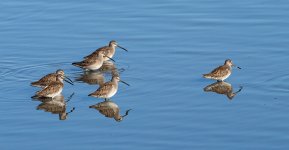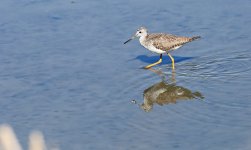-
Welcome to BirdForum, the internet's largest birding community with thousands of members from all over the world. The forums are dedicated to wild birds, birding, binoculars and equipment and all that goes with it.
Please register for an account to take part in the discussions in the forum, post your pictures in the gallery and more.
You are using an out of date browser. It may not display this or other websites correctly.
You should upgrade or use an alternative browser.
You should upgrade or use an alternative browser.
Dowitcher & Yellowlegs (1 Viewer)
- Thread starter sirijay
- Start date
More options
Who Replied?Yes those would be my suggestionsAgree with Greater Yellowlegs with the broad-based bill.
Suspect you're correct with the dowitcher ID too.
Interesting... the photos were taken at the Las Gallinas Water Sanitary Plant ponds. I assume these are "fresh water" (waste water) treatment ponds. According to Sibley (I just looked this up), the long bills prefer fresh water but it seemed to me that the short bills may be found in both.
Seanbirds
Amateur photographer

True.According to Sibley (I just looked this up), the long bills prefer fresh water but it seemed to me that the short bills may be found in both.
connorco
Well-known member

Las Gallinas is one of the most popular and overbirded places in Marin County. They are freshwater ponds. While Short-billeds can show up in migration, and a few overwinter, almost all dowitchers there are Long-billed. The short-billed reports are usually by inexperienced birders, of which there are many in the area. Short-billed are very difficult to find in Marin County compared to the rest of the Bay Area.Interesting... the photos were taken at the Las Gallinas Water Sanitary Plant ponds. I assume these are "fresh water" (waste water) treatment ponds. According to Sibley (I just looked this up), the long bills prefer fresh water but it seemed to me that the short bills may be found in both.
Reconsidering these: perhaps you're right. Rightmost dowitcher looks a bit more like short-billed?The dowitchers look like Long-billed Dowitchers to me.
jmepler
It's just a flesh wound.

Las Gallinas is one of the most popular and overbirded places in Marin County. They are freshwater ponds. While Short-billeds can show up in migration, and a few overwinter, almost all dowitchers there are Long-billed. The short-billed reports are usually by inexperienced birders, of which there are many in the area. Short-billed are very difficult to find in Marin County compared to the rest of the Bay Area.
So, are you saying that you think these are Long-billed Dowitchers? Many people make the mistake of assuming that the likely species is the one they are seeing. This is particularly problematic with difficult to identify species, such as dowitchers.
I checked bill-to-head length ratios for the birds pictured. They were as follows: 1.61, 1.64, 1.56, 1.60, 1.55, and 1.60:1. These are all below the minimum of 1.70:1 for Long-billed Dowitcher, and right around the median of 1.60:1 for Short-billed Dowitcher. Bill shape (drooping tip) looks better for SBDO too.
Any more pictures? Under wing shots are particulary useful.
Some additional information on dowitcher identification here and here.
connorco
Well-known member

I would say they should be left unidentified, but they are most certainly LBDO.So, are you saying that you think these are Long-billed Dowitchers? Many people make the mistake of assuming that the likely species is the one they are seeing. This is particularly problematic with difficult to identify species, such as dowitchers.
I checked bill-to-head length ratios for the birds pictured. They were as follows: 1.61, 1.64, 1.56, 1.60, 1.55, and 1.60:1. These are all below the minimum of 1.70:1 for Long-billed Dowitcher, and right around the median of 1.60:1 for Short-billed Dowitcher. Bill shape (drooping tip) looks better for SBDO too.
Any more pictures? Under wing shots are particulary useful.
Some additional information on dowitcher identification here and here.
jmepler
It's just a flesh wound.

I would say they should be left unidentified, but they are most certainly LBDO.
Most certainly based on what?
connorco
Well-known member

Most certainly based on location and time of year. I agree with you that birds should not be fully eliminated based on if they are expected or not. However, Las Gallinas is heavily birded, and while there might be some winter records from ebird, only one is from a reliable birder, and it was a single individual mixed in with Long-billed. Also, this location is checked a lot, and I and many other birders have confirmed that the vast majority of the wintering flock that stays at the first pond (where this presumably is, considering the dowitchers don't regualrly go to Pond 2 and 3 other then in migration) are almost all Long-billed.Most certainly based on what?
Users who are viewing this thread
Total: 2 (members: 0, guests: 2)






